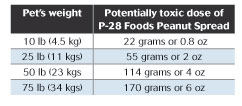





Your dog's favorite treat might contain a deadly toxin.
Peanut butter is a special dog treat in many households. It's gooey goodness is perfect for hiding doggy medicines and makes a delicious filler for long-lasting treat dispensers. The addition of a new sweetener to peanut butter recipes, however, turns this tasty treat into a dangerous toxin. Making your own peanut butter is the safest way to protect your dog from harm.
What Is Xylitol?
Some peanut butter manufacturers recently switched to a sweetener called xylitol. Xylitol is a naturally occurring sugar substitute that is safe for humans and even promotes better oral hygiene, according to dental hygienists. The sweetener is low in calories and has a low glycemic index, which means it does not raise your blood sugar as much as regular sugar. This makes it a safer sugar choice for diabetics and those looking to cut calories. Xylitol is also found in sugar-free gum, breath mints, toothpaste and an increasing number of other processed foods.
Xylitol might not harm us, but it is toxic even in small amounts for dogs. The chart below from Veterinary News illustrates the toxicity of xylitol in one brand of xylitol-containing peanut butter. It measures the amount of peanut butter considered toxic for a 10, 25, 50, and 75-pound dog. To put things into perspective, one teaspoon of peanut butter contains approximately 5 grams. A ten-pound dog would need to consume 4.4 teaspoons of peanut butter to receive a toxic dose.

Image Courtesy: Veterinary News
Keep in mind that there are 3 teaspoons in 1 tablespoon. Next time you give your dog a peanut butter snack, measure how much you normally feed him. 4.4 teaspoons might sound like a lot, but it is actually only a slightly larger helping size than most people give their dogs.
If peanut butter is a regular treat in your household, xylitol poses an even larger risk. Dogs who receive toxic doses are at risk for hypoglycemia and hepatic necrosis, and dogs who associate peanut butter with a delicious treat might be at larger risk of nabbing the entire jar. A jar of peanut butter containing xylitol could kill your dog long before you returned home from work.
So far only a few manufacturers use xylitol in their peanut butter, but the growing trend poses a threat to well-meaning dog owners who fail to read the nutrition panel. The human health and cost benefits of switching to xylitol appeal to manufacturers, which means that xylitol is probably here to stay.
Conscientious dog owners should be wary of any processed human food they feed their pets. It is our responsibility to be aware of the risks. Luckily, there is an even better way to prevent your dog from ingesting xylitol: making your own peanut butter.
Dog-Friendly Peanut Butter Recipes
Making your own peanut butter is easy, enjoyable, and delicious. Most recipes call for roasted peanuts, a sweetener, and an oil. You make the decision about how much sugar or salt to add, controlling your diet and eliminating artificial flavors and preservatives. The best part about homemade peanut butter is the effort involved - almost zero. The entire process takes ten minutes or less.
This modified homemade peanut butter recipe for dogs from pet magazine The Bark makes one cup of peanut butter.
Ingredients:
1 1/2 cup of unsalted, roasted peanuts
1 tsp of honey, molasses, or sweetener
1 tsp of peanut, safflower, or vegetable oil
Place all of the ingredients in a food processor until the mixture is smooth and easily spread. This takes between three and five minutes. Refrigerate the finished product for up to one month.
This is a great basic recipe for homemade peanut butter that both humans and dogs love. It is healthier than store-bought peanut butter and allows you to adjust the ingredients according to taste. If you plan on making this recipe for yourself as well as your dog, you might want to add a little salt to taste.
If you don't plan on enjoying your homemade peanut butter with your pooch, consider cutting back or eliminating the sugar altogether. Your pup won't mind at all and will be healthier for the omission.
Make Your Own Dog Treats With Homemade Peanut Butter
Not only is homemade peanut butter great for feeding straight off the spoon to your eager retriever, it is also a key ingredient in homemade dog treat recipes. Peanut butter gives biscuits and frozen treats that irresistible flavor dogs love.
As you make your homemade dog treats, think about the quality of the ingredients. Choose natural ingredients and stay away from processed additives. Avoid unnecessary fats and sugars and consider ingredients that promote healthy skin, coats, and digestion.
Dogs love frozen treats year round. Peanut butter mixed with mashed bananas, pumpkin, or sweet potatoes make an excellent doggy popsicle. Spoon the mixture, combined with a little water, into an ice cube tray. When the cubes are frozen solid, give them as a special treat for your best friend. Just avoid feeding treats on carpets, as the oils in the peanut butter could stain.
National Peanut Butter Lover's Month
November is National Peanut Butter Lover's month. Nobody loves peanut butter as much as your dog. Help him or her celebrate with a delicious, homemade peanut butter. Not only will your pet appreciate the nutty snack but you will also protect him from xylitol toxicity.
Copyright © www.100flowers.win Botanic Garden All Rights Reserved